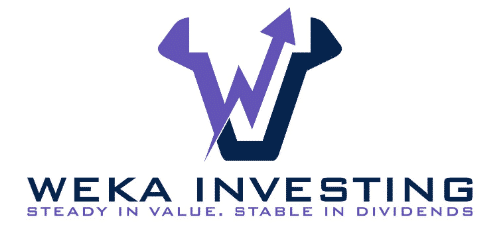We prioritize purchasing undervalued stocks, focusing on those trading below their intrinsic values. This approach emphasizes financial stability and long-term growth, leaning heavily on fundamental indicators for a thorough analysis. A key component is the margin of safety, which buffers against market volatility. We evaluate dividend yields for their income potential, seeking sustainable, quality investments over mere short-term gains. Evaluating companies' financial health, return on equity, and debt levels are essential, alongside understanding their business models and growth prospects. Our methodical approach combines this with gauging stock value through financial metrics and market dynamics. By adhering to these principles, we guarantee our investments are both wise and rewarding, setting a solid foundation for further insights into achieving long-term financial freedom.
Key Takeaways
- Focus on purchasing undervalued stocks that trade below their intrinsic values for long-term growth.
- Dividend yields are crucial, with an emphasis on sustainable, quality investments that suggest a better return on investment.
- Assess company quality through financial health, management effectiveness, and consistent dividend payments.
- Evaluate stock value using metrics like P/E ratio and price to book value, balancing dividend yield and growth potential.
- Prioritize financial soundness, looking at ratios like Debt-to-Equity and ensuring the company has a strong foundation for sustainable growth.
Understanding Value Investing
At the heart of value investing lies the strategy of purchasing undervalued stocks that trade for less than their intrinsic values, providing a margin of safety against market volatility. This approach requires a methodical analysis, focusing on financial stability and the potential for long-term growth rather than short-lived market trends. We investigate this method, prioritizing stocks that display a significant discrepancy between their market price and intrinsic value.
Value investing isn't about quick wins; it's a commitment to a long-term perspective. We engage in fundamental analysis to uncover stocks that the market has overlooked. These are the undervalued stocks, gems hidden beneath the surface, waiting for their true worth to be recognized. By evaluating financial indicators such as the P/E ratio and P/B ratio, we can assess a stock's actual value versus its current trading price. This process is crucial in identifying investment opportunities that others might miss.
Our focus remains steadfast on the margin of safety, a principle that acts as a buffer against the unpredictable nature of markets. It's not just about buying cheap stocks; it's about ensuring there's a substantial difference between the price paid and the stock's intrinsic value. This difference is our safeguard, providing us with the freedom to invest with confidence, even in turbulent times.
Emphasizing financial stability, we're not swayed by fleeting market sentiments. Our goal is clear: to buy stocks at a discount to their true worth, anchoring our investments in solid fundamentals. This approach guarantees we're positioned for sustainable, long-term growth, aligning perfectly with the desires of those seeking financial freedom through value investing.
Importance of Dividend Yields

Dividend yields serve as a crucial metric for investors, reflecting the annual dividend payment of a company as a percentage of its stock price, thereby providing a clear indication of the income potential from an investment. For us, dividend investors, understanding and leveraging the power of dividend yields are pivotal. It's not just about the allure of receiving regular income; it's about the strategic insight dividend yields offer into the return on investment.
Higher dividend yields often suggest a better return on investment, but they're not the only factor to ponder. We're constantly monitoring dividend yields across different sectors, recognizing that yields can vary significantly. This variation helps us make informed decisions, balancing our portfolios to achieve the desired mix of income potential and risk.
To convey the importance of dividend yields more clearly, consider the following table:
| Sector | Average Dividend Yield (%) |
|---|---|
| Utilities | 4.5 |
| Technology | 1.2 |
| Real Estate | 3.7 |
| Consumer Goods | 2.9 |
This table illustrates the diversification in dividend yields across sectors, emphasizing the need for us to be methodical in our investment approach. We're not just chasing high yields; we're seeking sustainable, quality investments that promise long-term growth and stability. By fully understanding and effectively monitoring dividend yields, we're better positioned to achieve our goals, ensuring our freedom and financial well-being through prudent investment choices.
Assessing Company Quality
Assessing a company's quality is a crucial step in value investing, requiring a thorough analysis of financial health, management's effectiveness, and its competitive edge in the market. We investigate financial statements to examine return on equity, profit margins, and debt levels, aiming to measure the company's ability to generate returns for shareholders efficiently and sustainably. These metrics serve as the pillars of our evaluation, guiding us to make well-informed decisions.
Understanding a company's business model and industry position further enriches our assessment. It's essential to grasp how a firm generates revenue and its standing among competitors. This insight, combined with an evaluation of growth prospects, provides a glimpse into the future, helping us determine whether the company is on a path to lasting success.
Consistent dividend payments and stable cash flows are essential signs of a company's financial health. These indicators, along with a history of earnings growth, indicate resilience and reliability, traits we value highly. We're particularly attracted to firms that demonstrate sustainable competitive advantages and strong brand recognition, as these factors often lead to market dominance and superior long-term performance.
Evaluating Stock Value

To accurately determine a stock's worth, we delve into metrics such as the price to earnings (P/E) ratio, price to cash flow, and price to book value, guaranteeing a thorough analysis of its value for dividend investments. These financial metrics serve as the cornerstone of our analysis, guiding us in identifying stocks that aren't just high in dividend yield but also fundamentally strong and undervalued.
Understanding the intrinsic value of a stock is critical for us as dividend investors. It's not just about the allure of immediate returns; it's about recognizing the potential for long-term growth and sustainability. By comparing the stock's current price to its intrinsic value, we're able to spot opportunities where the market may have overlooked the true worth of a dividend-paying company.
Moreover, we don't shy away from leveraging technical analysis to complement our valuation efforts. Tracking stock price movements helps us gauge market sentiment and timing, which, although secondary to fundamental analysis, enhances our decision-making process.
In our pursuit of value, we're always on the lookout for stocks that offer a balance between a reasonable dividend yield and growth potential. It's this balance that often signals a sound investment opportunity, aligning with our goal of achieving freedom through smart, disciplined investing.
In essence, our approach to evaluating stock value is methodical and rooted in a deep understanding of financial metrics, intrinsic value, and market dynamics. This disciplined methodology ensures we're not just chasing dividends, but investing in the true value of a stock for substantial and sustainable returns.
The Role of Financial Soundness

Evaluating a company's financial soundness, particularly its long-term debt levels, is crucial in determining its operational stability and investment viability. As proponents of value investing, we comprehend that the principles of value investing are not just about acquiring dividend stocks at a discount to their intrinsic value but also ensuring these stocks represent companies with robust financial health. Financial soundness is a cornerstone for sustainable growth and equity investment, as it demonstrates a company's ability to withstand market volatilities and capitalize on growth opportunities without the burden of excessive debt.
Let's consider the significance of financial ratios in gauging a company's financial robustness:
| Ratio Type | Importance |
|---|---|
| Debt-to-Equity Ratio | Lower ratios indicate a company relies less on borrowing, reducing risk. |
| Interest Coverage Ratio | Higher ratios show a company can easily meet its interest obligations. |
| Current Ratio | Measures liquidity; higher ratios suggest better short-term financial health. |
| Price-to-Earnings (P/E) Ratio | Helps evaluate if the current stock price reflects the company's earnings potential. |
These ratios provide insights beyond the current stock price, highlighting the financial stability and growth potential of value stocks. A company with low long-term debt not only enjoys more operational flexibility but can also redirect cash flow towards expanding operations rather than servicing debt. This is why the principles of value investing emphasize financial soundness as a key criterion when selecting dividend stocks for long-term investments. It's not just about the yield today but ensuring the company can sustain and grow dividends over time, contributing to the overall value of our equity investment.
Recognizing High-Yield Risks

While delving into the appeal of high-yield dividend stocks, it's essential that we grasp that these investments often come with heightened risks, including the potential for unsustainable dividend payouts. As advocates of value investing, we must recognize that chasing high dividend yields without evaluating the underlying financial health of a company can lead us down a precarious path. High-yield dividends may seem attractive at first glance, offering the allure of immediate income, but they're not without their pitfalls.
Economic downturns can greatly impact a company's ability to sustain its dividend payments, putting dividend investors at risk of income loss. Moreover, high dividend yields can sometimes be a red flag for financial distress within a company, potentially leading to dividend cuts. This is a scenario we must diligently avoid to protect our dividend income and safeguard the longevity of our investments.
To mitigate these risks, it's vital that we monitor the financial health of companies offering high yields. Diversification also plays a key role in risk mitigation. Relying too heavily on high-yield dividend stocks can expose us to undue risk, underlining the importance of a balanced portfolio.
In the domain of dividend investing, understanding and recognizing the risks associated with high dividend yields is fundamental. By doing so, we protect our investments against financial distress and sustain our dividend income. Through vigilant analysis and strategic diversification, we can navigate the complexities of high-yield investments while staying true to the principles of value investing.
Long-Term Growth Strategies

Having understood the risks associated with high-yield dividends, let's now focus on the importance of long-term growth strategies in dividend investing. We're pursuing not just immediate returns but the freedom that comes from sustainable growth and the compounding of returns over time. This commitment to long-term growth is central to value investing and guarantees that we're not just chasing dividends, but investing in companies poised for steady growth.
To achieve this, we prioritize dividend-paying stocks that demonstrate a history of increasing dividends. This is a sign of a company's health and its ability to generate consistent income alongside potential stock appreciation. Here's how we approach this:
- Focus on Quality: We seek out companies with strong fundamentals, believing in the principles of value investing. This disciplined approach helps us identify stocks that offer sustainable growth, not just immediate yields.
- Compounding Returns: By reinvesting dividends, we harness the power of compounding, which greatly boosts our investment's value over time. This strategy is key to achieving long-term financial freedom.
- Increasing Dividends: We target companies known for raising their dividends. This is often a signal of a company's confidence in its future and its commitment to returning value to shareholders.
Through these strategies, we guarantee that our dividend investing isn't just about collecting payouts but about building a portfolio that delivers sustainable, long-term growth. This disciplined, principled approach to selecting dividend-paying stocks is what sets us apart and moves us closer to our goals of financial freedom and steady growth.
Insider Ownership Insights

A significant indicator of a company's faith in its own growth prospects is the level of insider ownership. As value investors, we're always on the lookout for signals that can guide us towards companies with a solid foundation for long-term value creation. Insider ownership, the share of company stocks held by its executives, directors, or employees, serves as a critical barometer for evaluating this foundation. It's not just a number; it's a showcase of confidence.
When management teams hold a significant portion of company shares, it creates a natural alignment of interests with shareholders. This alignment is key in value investing, as it guarantees that the decisions made by the company's leaders are likely also to benefit us, the investors. We see insider buying as a particularly encouraging sign. It suggests that those with the deepest insights into the company's operations and future prospects are betting on its success. This isn't just a casual endorsement; it's a commitment to the company's trajectory.
Monitoring changes in insider ownership can provide us with valuable insights into management's sentiment and outlook. An increase in insider ownership is often perceived as a sign of stability and a shared commitment to the company's long-term success. Conversely, a decrease might warrant a closer examination.
For those of us seeking freedom through our investments, understanding the dynamics of insider ownership offers a path to aligning with companies where management teams aren't just employees but committed partners in growth. This alignment is a cornerstone of shareholder alignment and, ultimately, the stability and prosperity of our investments.
Business Strategy Fundamentals

After understanding the importance of insider ownership, we now turn our attention to the core of a company's potential for longevity and growth: its business strategy fundamentals. In value investing, especially for us dividend investors, deeply analyzing and understanding a company's business strategy is paramount. This strategic insight informs our investment decisions, helping to secure long-term success.
Evaluating the soundness of a company's business strategy involves a few key considerations:
- Management Outlook: We scrutinize the leadership team's vision for the company's future. This includes evaluating their plans for steering through challenges and seizing opportunities. A clear, realistic management outlook is often indicative of a company's potential for sustainable growth.
- Plans for Future Growth: It's critical to understand how a company intends to grow. This could involve expanding into new markets, innovation in products or services, or strategic acquisitions. The viability and creativity of these growth plans heavily influence our confidence in the company's future.
- Soundness of Strategy: We methodically assess the feasibility and competitiveness of the business strategy. This requires analyzing the company's position within its industry, its competitive advantages, and how these might evolve over time.
For us, diving deep into these aspects of a company's business strategy isn't just about ensuring the safety of our investment. It's about affirming our freedom to make informed choices, leading to more predictable streams of dividend income and, ultimately, achieving financial independence. By diligently scrutinizing fundamentals, we place ourselves in a better position to identify companies poised for long-term success, making our journey in dividend investing not just rewarding but also secure.
Positive Earnings Analysis

In our journey toward financial independence through dividend investing, we carefully examine positive earnings analysis, a critical step in gauging a company's profitability and growth potential. This methodical approach allows us to sift through countless options to pinpoint those gems that promise not just dividends but also a sustainable performance over time. Through positive earnings analysis, we're not just investors; we become partners in a company's growth story.
Positive earnings analysis involves delving deep into a company's financial statements to understand its earnings trends. These trends are vital for us, as they indicate the company's ability to generate profits consistently. This capability is crucial for dividends paid out to us, the shareholders. After all, dividends are paid from profits, and a company without positive earnings may struggle to sustain dividend payments.
Moreover, positive earnings reflect on a company's book value, impacting our stock ownership's intrinsic value. For value investing devotees, this analysis is the cornerstone of making informed decisions about stock valuations. It informs us not just about the current financial health of a company, but also about its potential for future growth. Growth investors, in particular, can benefit from spotting these trends early on, as they often precede stock price appreciation.
In essence, positive earnings analysis is more than a mere review of numbers. It's an essential practice in our quest for financial freedom. It ensures that our investments are grounded in companies with solid fundamentals, promising a path to wealth accumulation through both stock appreciation and dividends.
Technical Analysis in Value Investing

Turning now to technical analysis in value investing, we explore how studying stock price movements and patterns can predict future price changes, complementing our fundamental analysis for more informed investment decisions. We're delving into the world of charts and graphs, where historical price data and volume trends speak volumes about potential investment opportunities. By interpreting these signals, we're not just guessing; we're strategizing with precision to identify the ideal moments to buy or sell.
Here's what makes technical analysis indispensable in our toolbox:
- Historical Price Data and Volume Trends: We rely on this to catch glimpses of market sentiment and potential price movements before they become obvious to the market at large.
- Moving Averages and Chart Patterns: These tools help us smooth out the noise and detect patterns, such as head and shoulders or triangles, which indicate potential market shifts.
- Support and Resistance Levels: By understanding these, we can better predict where the price might hesitate or bounce back, offering us strategic points for entry or exit.
Technical analysis, with its focus on stock price movements, buy and sell signals, and market indicators like moving averages and volume trends, serves as a powerful adjunct to our value investing philosophy. It's not just about the numbers on a balance sheet; it's about understanding market psychology, support and resistance levels, and chart patterns to make decisions that are informed not just by the value of a company, but by the market's perception of that value. In our pursuit of freedom through investing, it's a critical tool for exploring the markets with confidence and precision.
Achieving Sustainable Returns

How do we guarantee our dividend investments yield sustainable returns over the long term? Through value investing, we prioritize quality companies with a track record of consistent dividend payments. These companies often have a strong financial foundation and stable cash flows, essential for sustaining returns. Here's a deeper exploration into how we achieve this:
| Strategy Element | Why It Matters |
|---|---|
| Financial Foundation & Stable Cash Flows | A robust financial base guarantees that a company can weather economic downturns, maintaining dividend payments. |
| Balance between Dividend Yield & Growth Potential | High dividend yield might be tempting, but a balance ensures longevity and capital appreciation. |
| Diversification | Spreading investments across sectors reduces risk and stabilizes returns. |
Investing in companies with both a healthy dividend yield and growth potential requires a systematic approach. It's not simply about pursuing the highest dividend yield but understanding the underlying business's quality. Diversification is our safeguard against volatility, ensuring we're not overly exposed to any single sector's downturn.
We regularly monitor and adjust our portfolio, responding to company performance and market conditions. This proactive management is key to sustaining returns in dividend investing. By adhering to these principles, we aim to achieve the freedom that comes with a consistent and growing income stream. Essentially, value investing in dividend stocks is about more than just immediate returns; it's about building a portfolio that delivers sustainable growth and income over time.
Frequently Asked Questions
What Is the Key Principle of Value Investing?
We're often asked about the cornerstone of value investing, and it's all about snapping up stocks for less than they're truly worth. By digging deep into a company's fundamentals, we aim to find those hidden gems that the market's overlooked.
It's not just about quick wins; we're in it for the long haul, seeking solid, undervalued stocks that'll give us the freedom and financial security we're after.
What Are the Fundamentals of Value Investing?
We're diving deep into value investing's core, where buying underpriced stocks is our treasure hunt. It's about uncovering gems—companies solid in earnings, cash flow, and book value, yet overlooked. We seek that safety margin, a buffer against market whims.
Patience and a contrarian view are our tools, aiming to spot opportunities missed by others. It's our path to freedom, securing financial growth through wise, calculated choices.
Is Value Investing the Same as Dividend Investing?
We're often asked if value investing is the same as dividend investing. While they share similarities, they're not identical.
In value investing, we look for stocks selling below their true worth. Dividend investing, on the other hand, focuses on firms that regularly pay dividends.
What to Look for When Investing in Dividends?
When we're investing in dividends, we're looking for consistency, yield, and growth.
We evaluate the dividend's yield and its payout ratio, confirming the company's financial health supports sustainable payments.
We also analyze the dividend growth rate, aiming to secure not just immediate returns but also future growth potential.
This methodical approach guarantees we're not just chasing high yields but investing in companies that offer stability and long-term value.
Conclusion
To sum up, we've meticulously navigated the terrain of value investing, focusing on dividends as our beacon. Some argue that this path limits growth potential, conjuring images of slow-moving, antiquated investments. Yet, we see a lush landscape ripe with opportunities for sustainable growth and reliable income.
By prioritizing company quality, evaluating stock value, and maintaining a disciplined approach, we're planting seeds in fertile ground, poised for long-term compounding growth. Our strategy isn't just about survival; it's about thriving.

Dr. Lincoln C. Wood teaches at the University of Otago in New Zealand. He is an avid investor and educator. He loves cash flow, income, and dividends when investing. He likes to buy undervalued companies with strong advantages and earnings growth.



